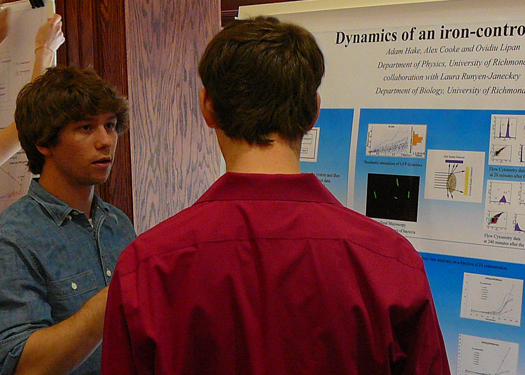Junior Bernard Wittmaack, ‘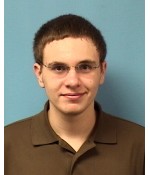 11, traveled to San Juan, Puerto Rico this fall to present a talk on his research at a meeting of the American Chemical Society. Bernard studies halogen bonding in group 14 halomethane analogues with chemistry professor Kelling Donald, using computational chemistry techniques. The two have performed intensive calculations using a supercomputer cluster here at Richmond, and expect to publish their work soon. Bernard is majoring in interdisciplinary physics with a chemistry concentration, allowing him to combine courses from both disciplines.
11, traveled to San Juan, Puerto Rico this fall to present a talk on his research at a meeting of the American Chemical Society. Bernard studies halogen bonding in group 14 halomethane analogues with chemistry professor Kelling Donald, using computational chemistry techniques. The two have performed intensive calculations using a supercomputer cluster here at Richmond, and expect to publish their work soon. Bernard is majoring in interdisciplinary physics with a chemistry concentration, allowing him to combine courses from both disciplines.
Author: mtrawick
Research Update: Calina Copos, '10
Senior physics major 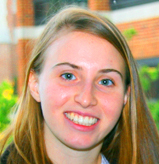 Calina Copos, '10, has been active in research with professor Jerry Gilfoyle, using the Richmond Physics Department’s supercomputer to run computationally intensive simulations to better understand the precision of the experiments they are doing at Jefferson National Laboratory. The two are part of a team working to measure the distributions of electric charge and magnetic field within a single proton. Calina traveled to Hawaii this fall to present the results of her work at a national conference of the American Physical Society’s Division of Nuclear Physics.
Calina Copos, '10, has been active in research with professor Jerry Gilfoyle, using the Richmond Physics Department’s supercomputer to run computationally intensive simulations to better understand the precision of the experiments they are doing at Jefferson National Laboratory. The two are part of a team working to measure the distributions of electric charge and magnetic field within a single proton. Calina traveled to Hawaii this fall to present the results of her work at a national conference of the American Physical Society’s Division of Nuclear Physics.
Jordan Wolfinger, '11, Travels to Australia
Junior Jordan Wolfinger, ’11,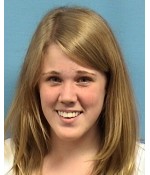 has spent her fall semester in Sydney, Australia. Besides continuing her physics studies there, she has also taken courses in finance and Australian history and traveled along Australia’s east coast. She also traveled to New Zealand, where she went bungee jumping at the world’s third highest location.
has spent her fall semester in Sydney, Australia. Besides continuing her physics studies there, she has also taken courses in finance and Australian history and traveled along Australia’s east coast. She also traveled to New Zealand, where she went bungee jumping at the world’s third highest location.
Research Update: Nick Annichiarico, '12
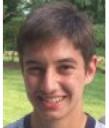 Sophomore physics major Nick Annichiarico, '12, has been working with Professor Ted Bunn, studying whether the universe has “handedness.” The two have been studying a database of information on the orientation of galaxies, searching for universal symmetry on a cosmological scale. Nick began working with Professor Bunn during the summer after his freshman year.
Sophomore physics major Nick Annichiarico, '12, has been working with Professor Ted Bunn, studying whether the universe has “handedness.” The two have been studying a database of information on the orientation of galaxies, searching for universal symmetry on a cosmological scale. Nick began working with Professor Bunn during the summer after his freshman year.
Research Update: Jack Shaw, '12
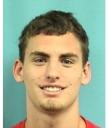 Sophomore physics major Jack Shaw, '12, is currently studying the effects of heat shock on mammalian cells. Jack has been working with Professor Ovidiu Lipan, a biological physicist, since the summer after his freshman year. Their work involves culturing Chinese hamster ovary cells that have been tagged with green fluorescent protein, and is supported in part by a $134,000 grant from the National Science Foundation.
Sophomore physics major Jack Shaw, '12, is currently studying the effects of heat shock on mammalian cells. Jack has been working with Professor Ovidiu Lipan, a biological physicist, since the summer after his freshman year. Their work involves culturing Chinese hamster ovary cells that have been tagged with green fluorescent protein, and is supported in part by a $134,000 grant from the National Science Foundation.
Ben Pauerstein, '12, and Cain Bonniwell, '11, present research in Hawaii
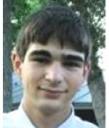
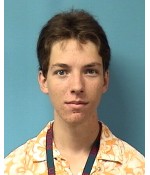 Physics majors Ben Pauerstein, ’12, and Cain Bonniwell, ’11, traveled to Kona, Hawaii this fall to present their research at the national conference of the American Physical Society’s Division of Nuclear Physics. The two are working with Professor Con Beausang, studying nuclear structure in the isotopes Gadolinium156 and Terbium 155.
Physics majors Ben Pauerstein, ’12, and Cain Bonniwell, ’11, traveled to Kona, Hawaii this fall to present their research at the national conference of the American Physical Society’s Division of Nuclear Physics. The two are working with Professor Con Beausang, studying nuclear structure in the isotopes Gadolinium156 and Terbium 155.
Welcome, admitted physicists and engineers!
If you are a newly admitted student planning to attend Richmond in fall 2009, please drop us a line! We like to stay in touch with potential physics and engineering students over the summer, to pass on information on course selection and research opportunities. (Probably only a couple of notes over the summer; we promise not to flood your inbox.) Please drop a quick note to Matt Trawick, and we’ll put you on our contact list. Welcome, class of 2013!
2009 UR student symposium highlights undergraduate research
Last week all UR students doing original research had a chance to share their work with others at Richmond during the 2009 student symposium. As usual, the physics department was well represented, with nine students presenting posters of their work, on topics ranging from cosmology to biological physics. Afterwards, the Society of Physics Students organized “Sky Watch,” during which all of the symposium participants could get a taste of astronomy and see the night sky through telescopes.
Visiting UR? Yes, you CAN sit in on a physics class!
If you are a prospective physics student visiting UR this spring, we would be happy to let you sit in on a physics class! It’s a great way to get a feel for what a Richmond physics class is really like. To set up a classroom visit, please contact our department admin, Mary Ann Stewart. (During the fall, classroom visits are arranged centrally by the UR admissions office. They don’t do it during the spring, presumably to avoid unmanageably large numbers during that busy time. But as usual, the physics department doesn’t play by the rules; we’re small enough that we can welcome visitors anytime if you contact us directly.)
Carrie Zegetosky '07: engineering with concrete
 Caroline Zegetosky graduated from Richmond in spring of 2007, having completed the Engineering dual degree program. She spent her first three years at UR, then continued as an undergraduate engineering student at the University of Virginia, one of our partner schools, where she is now a graduate student in civil engineering. Carrie uses the same atomic force microscopy techniques she learned here at UR to study the microstructure of different types of concrete, creating images such as the one to the right. (Nice pics, Carrie!)
Caroline Zegetosky graduated from Richmond in spring of 2007, having completed the Engineering dual degree program. She spent her first three years at UR, then continued as an undergraduate engineering student at the University of Virginia, one of our partner schools, where she is now a graduate student in civil engineering. Carrie uses the same atomic force microscopy techniques she learned here at UR to study the microstructure of different types of concrete, creating images such as the one to the right. (Nice pics, Carrie!)
Jim Stith speaks about careers in physics
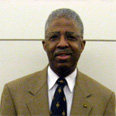 Jim Stith, recently retired as Vice President, Physics Resources Center for the American Institute of Physics, spoke at the University of Richmond about careers for physics students. The title of his talk was “The Physics Passport – Where does it take you?” Jim points out that of the 5500 yearly graduateswith bachelors degrees in physics, only a small number continue a “traditional path” of academic physics research. Many more continue in industry and government sector work, where their technical backgrounds and problem solving skills allow them to address a variety of challenging problems in different areas. Before coming to AIP, Dr. Stith was a Professor of Physics at The Ohio State University and also spent 21 years on the faculty of the United States Military Academy at West Point.
Jim Stith, recently retired as Vice President, Physics Resources Center for the American Institute of Physics, spoke at the University of Richmond about careers for physics students. The title of his talk was “The Physics Passport – Where does it take you?” Jim points out that of the 5500 yearly graduateswith bachelors degrees in physics, only a small number continue a “traditional path” of academic physics research. Many more continue in industry and government sector work, where their technical backgrounds and problem solving skills allow them to address a variety of challenging problems in different areas. Before coming to AIP, Dr. Stith was a Professor of Physics at The Ohio State University and also spent 21 years on the faculty of the United States Military Academy at West Point.
25 Random things about UR Physics
- The introductory physics courses are all small: capped at 24 students, though usually much smaller.
- Upper level physics courses are even smaller: usually no more than about 10 students in a class.
- We don't have any graduate students! Undergrads are taught by professors, and get to use all the cool equipment themselves.
- Intro physics courses are taught in a "workshop style," where laboratory and classroom elements are integrated together. (No separate 3-hour labs, taught by grad students, that aren't related to the lectures.)
- Favorite study break: liquid nitrogen ice cream!
- About 6-10 physics students graduate each year.
- All of the tenure-line physics faculty are active researchers, making discoveries and publishing their findings€”all with the help of undergraduate students.
- Do the math: with a small number of majors and lots of research to be done, all students have a chance to get involved, usually by their sophomore years.
- First year students can get involved in research too: at least 8 of them, so far this year.
- 100% of the physics faculty have external funding for their research. (This means their research is recognized as important in their field. It also means more money and opportunities for their students.)
- Students doing research have coauthored papers with faculty in prestigious scientific journals.
- Students frequently travel to national and international scientific conferences to present their work. (Some recent destinations: Los Angeles, Denver, Hawaii, Alaska, St. Louis, Oakland€¦)
- Many of our physics students also study abroad: (Scotland, China, Australia€¦)
- Many students do research here over the summers, paid by external grants (NSF, etc.) or University fellowships.
- Many physics students are double majors, with a second major in math, computer science, chemistry, biology, political science, philosophy€¦.
- Students can graduate with either a B.S. or B.A. degree in physics. (The B.S. prepares you better for grad school or a technical career; the B.A. offers more flexibility for students with other interests.)
- Favorite physics student hangouts: either the physics student lounge, or any open classroom.
- Best place to watch major sporting events: on the projection TVs in the classrooms after hours.
- Our 3-2 engineering program offers students chance to do 3 years at Richmond, followed by 2 years at a partner engineering school. (Students have also gone straight to grad school in engineering after graduating with a straight-up physics degree.)
- Our resources include a state-of-the-art atomic force microscope and a supercomputer cluster, among other major instrumentation, plus very well equipped teaching laboratories.
- Most heavily used physics equipment: the coffee maker. (It's not even close.)
- After graduation, some students have gone on to physics graduate school (University of Chicago, University of Kentucky, Princeton, Johns Hopkins€¦)
- Other students have followed their dreams elsewhere after graduation: teaching English in China, doing software development in industry, actuarial mathematics, high school teaching….
- Physics students are really friendly! They study together and help each other, and the atmosphere is always fun and supportive.
- We like meeting new physics students. If you’re interested in physics, please come to visit us. 🙂
Emily Nelson ’12: Research Update
 First year student Emily Nelson has recently begun work on a research project with professor Matt Trawick that seeks to improve the accuracy of atomic force microscope images. The atomic force microscope in Trawick’s experimental research lab, a $200,000 instrument, is capable of resolving features on the scale of about one nanometer in size, about 1000 times smaller than conventional optical microscopes. Emily is working to correct for a particular kind of image distortion that is common to such microscopes; the correction would allow these instruments to be used for sub-nanometer precision measurements in three spatial dimensions, and would be broadly useful to researchers in a variety of fields. Emily expects to major in computer science, and also has interests in biology and the physical sciences.
First year student Emily Nelson has recently begun work on a research project with professor Matt Trawick that seeks to improve the accuracy of atomic force microscope images. The atomic force microscope in Trawick’s experimental research lab, a $200,000 instrument, is capable of resolving features on the scale of about one nanometer in size, about 1000 times smaller than conventional optical microscopes. Emily is working to correct for a particular kind of image distortion that is common to such microscopes; the correction would allow these instruments to be used for sub-nanometer precision measurements in three spatial dimensions, and would be broadly useful to researchers in a variety of fields. Emily expects to major in computer science, and also has interests in biology and the physical sciences.
Sarah Atwater ’09: Research Update
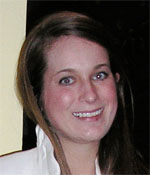 Senior Sarah Atwater is now working with professor Matt Trawick, studying the formation of vortices in a fluid as it is drawn over a surface in flow coating, a technique used to prepare thin polymer films. They are examining whether vortex formation may be responsible for observed defects in resulting films. Sarah began doing research during her sophomore year, analyzing angular correlations in molybdenum nuclei with professor Mirela Fetea.
Senior Sarah Atwater is now working with professor Matt Trawick, studying the formation of vortices in a fluid as it is drawn over a surface in flow coating, a technique used to prepare thin polymer films. They are examining whether vortex formation may be responsible for observed defects in resulting films. Sarah began doing research during her sophomore year, analyzing angular correlations in molybdenum nuclei with professor Mirela Fetea.
Berta Darakchieva ’09: Research Update
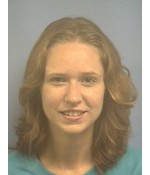 Berta spent her summer working at both Lawrence Berkeley National Laboratory and Yale University with Richmond Professor Con Beausang. Berta worked on two different projects: the first involved calculating transmission efficiency and count rates for detecting fission fragments at the focal plane of the Berkeley gas filled separater. The second involved analyzing data from an experiment done in Berkeley to populate low spin excited states in Gadolinium 154. Berta began working with professor Beausang as a freshman, and continues working with him this academic year.
Berta spent her summer working at both Lawrence Berkeley National Laboratory and Yale University with Richmond Professor Con Beausang. Berta worked on two different projects: the first involved calculating transmission efficiency and count rates for detecting fission fragments at the focal plane of the Berkeley gas filled separater. The second involved analyzing data from an experiment done in Berkeley to populate low spin excited states in Gadolinium 154. Berta began working with professor Beausang as a freshman, and continues working with him this academic year.
Whitney Brooks ’09: Research Update
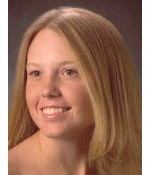 Whitney Brooks split her summer between Lawrence Berkeley National Laboratory and Yale University, working with Richmond professor Con Beausang. Whitney investigated “pile-up effects” in preamplifier output pulses from the prototype detector for the GRETINA array, the next leading US gamma ray microscope. Whitney continues her work this academic year.
Whitney Brooks split her summer between Lawrence Berkeley National Laboratory and Yale University, working with Richmond professor Con Beausang. Whitney investigated “pile-up effects” in preamplifier output pulses from the prototype detector for the GRETINA array, the next leading US gamma ray microscope. Whitney continues her work this academic year.
Mark Moog ’11: Research Update
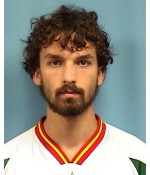 Mark Moog spent his summer studying particle physics with professor Jerry Gilfoyle. The two began their work together after Mark’s freshman year at UR. Mark used the University of Richmond supercomputer cluster to run simulations of a possible future experiment at the CEBAF accelerator at Jefferson National Laboratory in Newport, VA. The simulations address whether the experiment would be able to accurately measure the form factor of the neutron at high energies. In addition to his work at Richmond, Mark also traveled to Jefferson lab to help monitor the accelerator during ongoing experiments there. This fall, Mark travels with professor Gilfoyle to a national physics conference in Oakland, California to present the results of their work.
Mark Moog spent his summer studying particle physics with professor Jerry Gilfoyle. The two began their work together after Mark’s freshman year at UR. Mark used the University of Richmond supercomputer cluster to run simulations of a possible future experiment at the CEBAF accelerator at Jefferson National Laboratory in Newport, VA. The simulations address whether the experiment would be able to accurately measure the form factor of the neutron at high energies. In addition to his work at Richmond, Mark also traveled to Jefferson lab to help monitor the accelerator during ongoing experiments there. This fall, Mark travels with professor Gilfoyle to a national physics conference in Oakland, California to present the results of their work.

